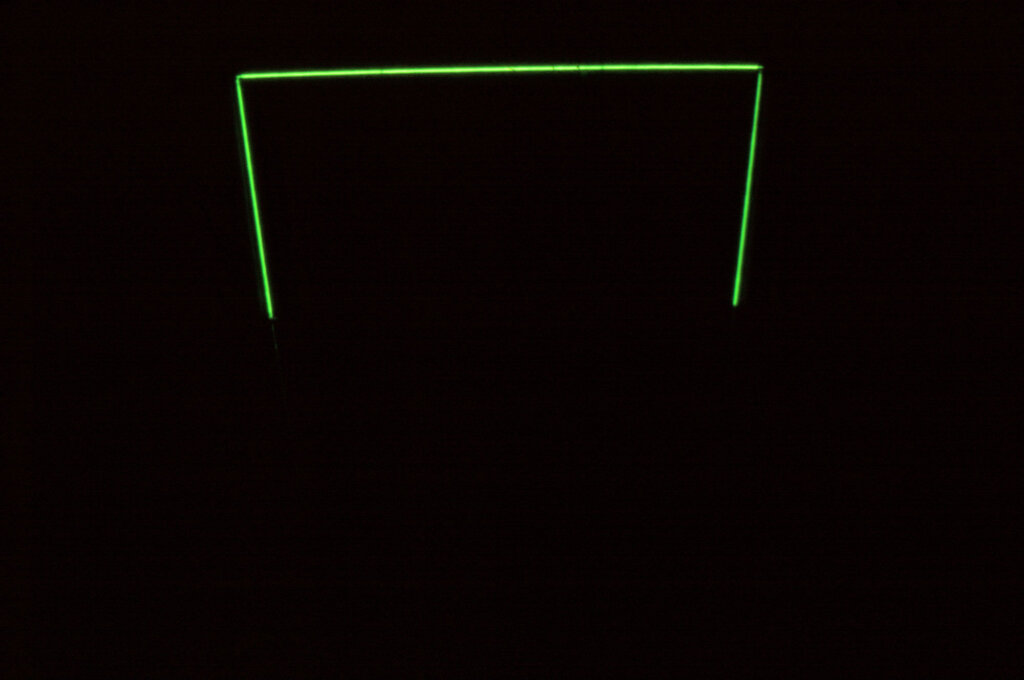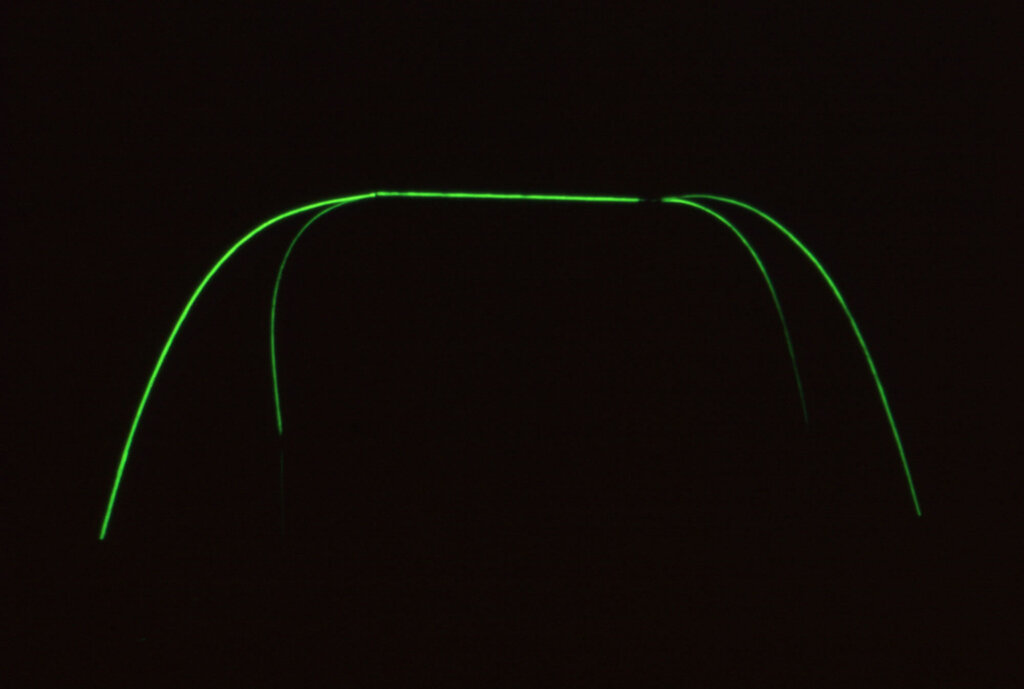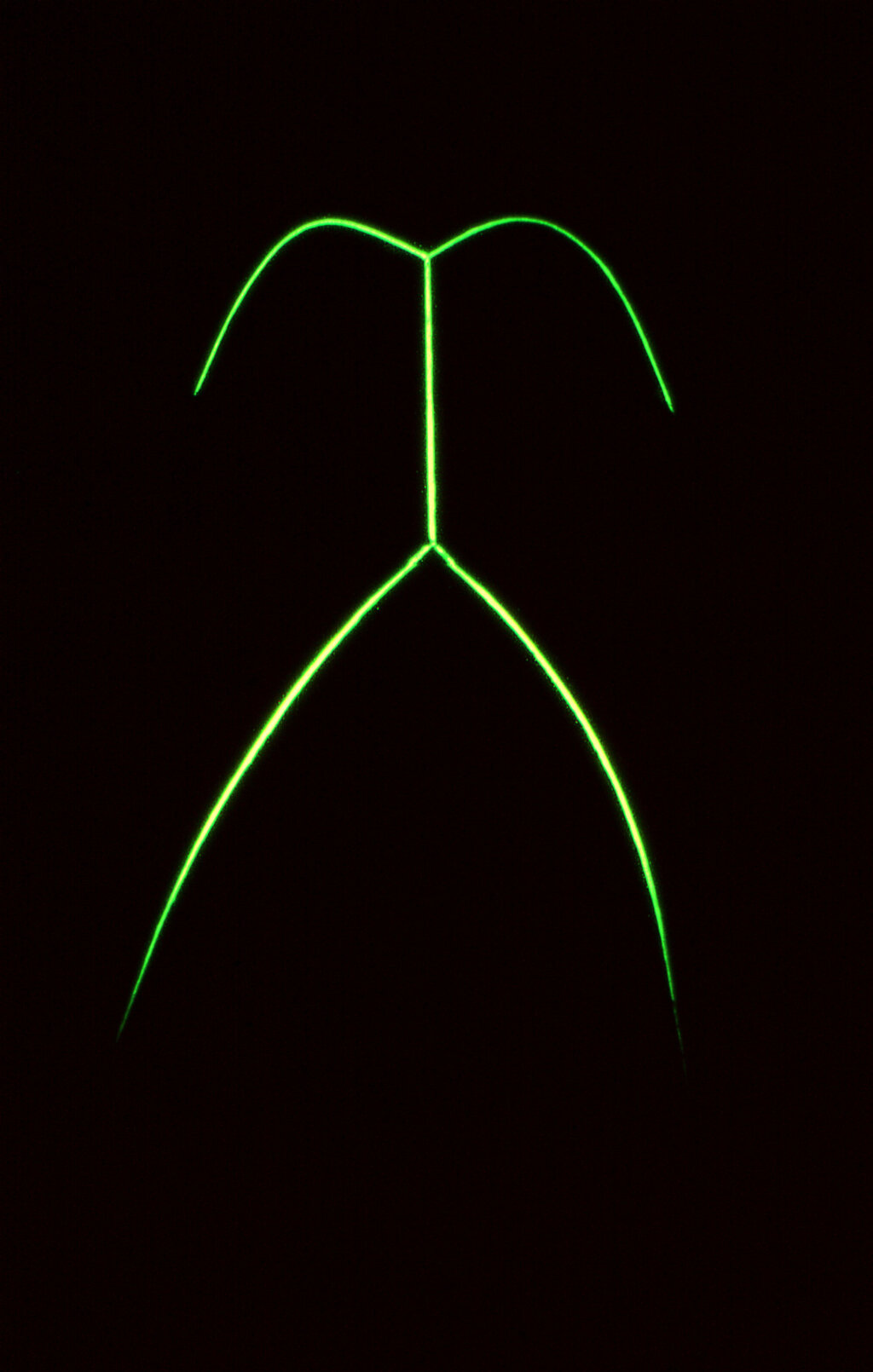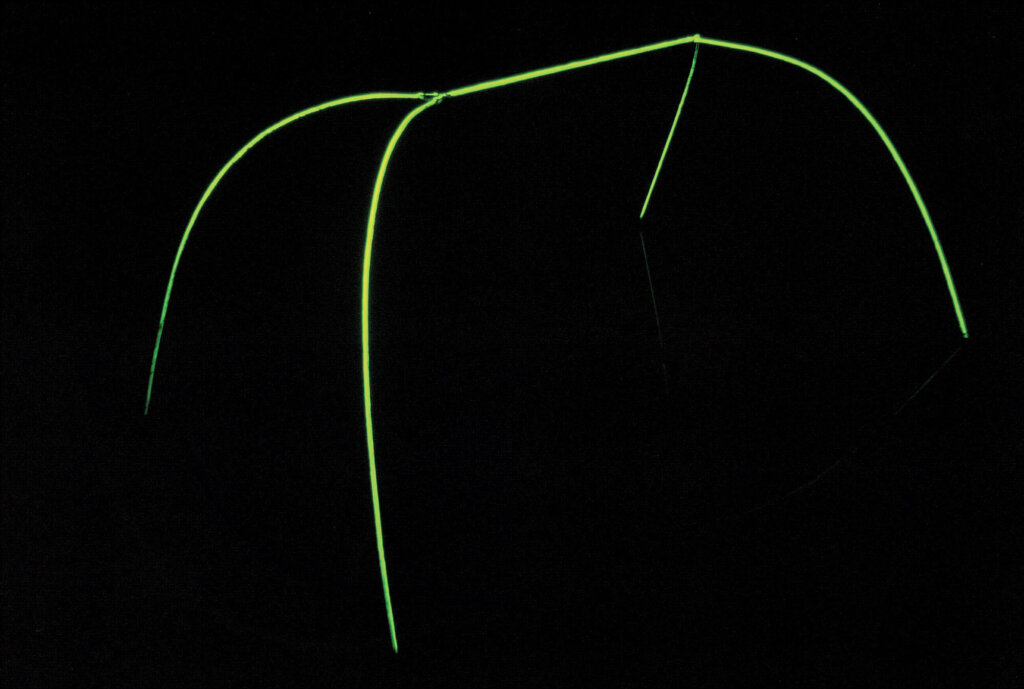”Communication”
the exhibitions:
– ”Communication” Wschodnia Gallery, Łódź, Poland, 1999
– ”Wymiana – Exchange”, Wieża ciśnień / Water Tower, Bydgoszcz, Poland, 1999
Two large metal sculptures were set up in two darkened rooms and communicated with each other by means of light. One sculpture was clearly geometric in form; the other was open or incomplete. Certain edges of the metal shapes were painted in luminous pigment which lit up for an indefinite period. To add to the effect, both sculptures were reflected in pools of water lying beneath them.
I wanted to explore how lively dialogue is possible between seemingly “dead” material in seemingly irreconcilable forms: closed – open (or perhaps male – female).
Technique: steel, luminous pigment, water, electric flash, electric light
“Communication” is the title of the exhibition in Wschodnia Gallery.
There is a silent sculpture standing there divided into two parts. The sculptures shapes can only be guessed, touched, imagined. They are (probably) very heavy and bulky, hard and cold. It contain water – but it is not certain, they are marked by silenced rays of greenish light shaped in form of an arch, a straight line and angle. All this comes to life through the rapid noise of a flash. Then, one has the feeling of having seen everything – every single detail of the silent sculpture. But it is only an illusion. After this short outbreak of light, darkness becomes even darker, and the sculpture – even more impenetrable…It becomes hard to talk to it.
The author of this exhibition is an artist from Lodz – Mariusz Sołtysik, whose other works, similar to “Communication”, are silent and contemplative, simple and without unnecessary fuss. They enable us to see our thoughts in various ways: by means of sculpture – installation, painting, performance or the discovery that in one of the rooms for example of a disused Australian power station something completely unexpected can be found: a piece of immaculate space and a swimming pool with Technicolor – like blue water, with four towels for those who would like to have a swim.
Swimming, they would see decaying walls of a factory that nobody needs, some broken machines, a leaking roof and an oily, rusty dust covering everything. Swimming, they would probably think about this extraordinary situation, through the roof – full of holes – the sun would come in, so it would be a perfect place for meditation…(“Just water”, Melbourne 1998).
This idea was elaborated on during the exhibition in Bydgoszcz. The ceiling over the heads of the visitors had a rectangular hole covered with water. Again, a quiet place for contemplation with the glimpse of watery light in the background and lime green walls around. (“…Either fish, or aquarium”, Bydgoszcz, 1998). And another space, this time arranged in Wales, this time a dark, black-arousing unspecified fear, dispersed by faint light coming from hardly visible nook hidden behind the wall, something was going on there – nobody knew what. Silence…(“Touching space”, Cardiff, 1997).
It’s apparent that the underlying theme of these exhibitions is that of geometry with colour. The construction was built of two different materials, e. g. paraffin and soil. It was not conspicuous, it was there only for its sake. Did anyone need it? It is impossible to solve.
Moving further on – at some point the object is transformed into an even less definite being. What is supposed to attract attention becomes almost completely invisible. What usually tells us a lot (if not everything) about the personality of the artist, told us nothing here. It was hidden in the wall, which was quite mysteriously cut by a ray of light. As a scar? A flaw? A fissure of unknown origin? The light was muffled by dimmed glass.
A few months later this ray moved a bit further, under a window (behind which a real late summer drama took place, the leaves rustling in the light of a lamp-post) accompanied by a flat cube. Consisting of paraffin and a substance resembling in colour to the soil of Kassel…( These pieces were created in the Lodz Museum of Artists and in the Grohmans Palace).
And so these unique objects appeared in various places. During the exhibition in India these objects were paraffin rings hung up – in a private house, on a tree, on a stone. They disappeared within a short time evaporated by the sun. The last one was placed on a road sign (“Sivas face”, Mount Abu, India, 1998).
The arrangement “Different forms” (Galeria Wschodnia, Lodz 1998) was telling of memorising, creating and selecting of impressions. Everything in the gallery manipulated and deceived the senses. It was caused by aggressive, suddenly terminating light, which illuminated about square shapes from the darkness. Some of them, painted, existed in reality. The others showed up with a flash for a few seconds and vanished into darkness, before one could see them in detail. They left us only with undefinable feeling.
The story of mutual permeability of impressions found its continuation in the performance “Time of (non) Attendance” (Galeria FF, Lodz 1998).
Then, two figures wrapped up in artificial cloth playing the main roles, were engrossed in their long dreams, which the audience could watch! One dream was set during a solitary walk along the notorious Wschodnia Street. The second, the quiet one, was governed by silent, swimming fish. The dreams intertwined – and then there was “Communication”…
text by Maciej Cholewiński






